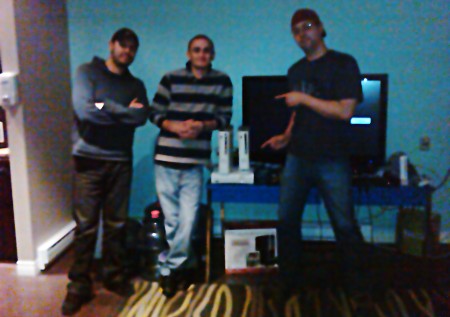X-Clamp replacement + heat gun: 360 fixed!!! February 26, 2010
Posted by Cesar in gaming me.Tags: 3rlod, e74, heat gun treatment, tips, x-clamp, xbox 360
add a comment

Another one for the collection of fixed 360s!!! On the picture, from left to right, Chris, Max and I. Chris had the infamous 3rlod a few weeks ago. This weekend we finally got all necessary tools and parts, yesterday we made and effort and guess what? It worked! I am proud to say his 360 is back to life.
This is the second time I fix a 360. By the end of 2008 my 360 died on me. I did a lot of research and with the help of my good friends Wallace and Jamir we resuscitated the dying Microsoft console. I have a new one here in Canada, but I hear my old friend is doing just fine back in Brazil.
Even thought the errors were different, the fixes were essentially the same: X-Clamp replacement + heat gun treatment. Want more details on the success story? Continue reading.
I found most of the information at the xbox-scene forums. They are a great source of information, with guys that work in repair shops and work on dozens of 360s every day.
The very first step when your 360 dies is to figure out the error. If you get any number of red lights, you can get an exact error number with a few tricks (turning the 360 on, pressing eject and some other crazy stuff). So go to this thread and find out the exact error you are having. That’s what you should research. Many errors, like the classic 3rlod and E74, can be fixed with the heat gun and prevented with the x-clamp replacement. Different errors require heat-gun focus on different areas, so make sure you find that out.
So if the error is related to motherboard bending, there’s a good chance it is fixable. I feel this asks for an explanation: in the 360 hardware, the heatsinks are attached to the motherboard with a clamp in X shape (duh): heatsink above, x-clamp below. When the 360 overheats, the x-clamp dilates a little and gets a bit out of place. When it cools down again, however, the clamp does not always go back to the original position. Sometimes when it shrinks back it is a bit skewed and that slightly bends the motherboard. The same process happening over and over again eventually causes microsolds in the motherboard to break. And that’s what causes most 3rlod and other issues.
The solution to the problem is to heat the motherboard up to a point where the microsolds melt and reconnect. If that happens, when the 360 cools down it is back in business. So heat is what fixes the problem, replacing the x-clamp is just a way to prevent it from happening again. That’s why the towel trick works (up to a point). Essentially what it does is overheat the whole hardware and reconnect the sold. But there is a huge number of drawbacks to the towel trick! Don’t do it, it causes more harm than good!
Anyway, back to the 360 surgery, if you got your error number and it is related to motherboard bending, follow one of the tutorials on this page . Read a lot, make sure you understand every step and try to improvise as little as possible. Important things to remember:
- be very careful with the components and the motherboard;
- make sure to clean the chips until they shine before applying the thermal compound. Be patient;
- make sure you use nylon washers or some other non-conductive thing to isolate the metal washers and screws from the motherboard. A very valid alternative is to cut your own washers out of old credit cards, they have the perfect height. Use a drill or a hole cutter and scissors;
- isolate all other components with a plastic layer and then a tin foil layer before using the heat gun. Don’t use just tin foil, you need insulation. Be specially careful with the capacitors, if they get too hot they will explode, don’t leave a single one exposed;
- use the heat gun as prescribed. Never get it too close to the motherboard and keep it moving slowly all the time, don’t stop. No matter how long you keep it there, a good indicator is the color of the sold. If you notice they get a bit of a golden hue (as opposed to the usual green/silverish look), you are almost done;
- if you hear popping, stop immediately. That means one of the capacitors is gone and your 360 is DOA. The capacitors are very probably replaceable, they are not so hard to sold, but I never got that far.
- it sounds silly but be careful removing the insulation plastic layer. Sometimes it melts and glues to the capacitors. When it cools down it is easy to remove, but you have to make sure no capacitors detach in the process.
It worked for Chris and me. But if it fails for you, don’t blame me, heh… Good luck!
See you space cowboys…
Let it snow February 6, 2010
Posted by Cesar in living me.Tags: blizzard, picture, snow
add a comment

It’s been snowing steadily since Thursday evening. And to make things even more interesting yesterday we had a blizzard. I wanted to go to work walking, just for fun, to pretend I was climbing the Everest or something. But Mariana convinced me otherwise.
Anyway, when I got back home by the end of the afternoon, with the blizzard hitting St. John’s all day, you couldn’t tell where the street started from where the sidewalk began.
So just to scare people back home I thought I could post a picture of the surroundings. I marched inside, got my camera and walked 30 feet to take the snapshot above.
You have to admit it is pretty!
See you space cowboys…



